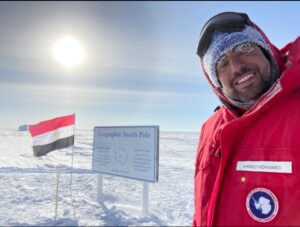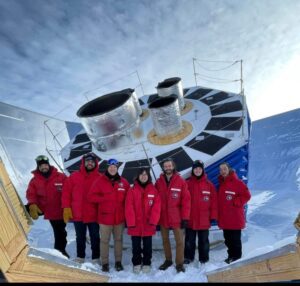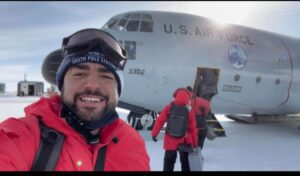Where would you go to find out how the universe came into being? Would you (a) go into deep space, (b) ask your mum, or (c) go to the South Pole?
An Egyptian scientist chose (c), not because he is a Saidi from the southern half of his country. Even so, 90 degrees south, 45 degrees east is as good a spot as any for a spot of cosmological inquiry. Besides, this is where the Norwegian explorer Roald Amundsen, who was one of five of the first human beings to venture to the southernmost point on the planet, planted his nation’s flag in December 1911.

A century plus 11 years on, researcher Ahmed Soliman told the Egyptian Mail about his experiences and his time in a tent similar to that used by the man from Norway.
“I am so proud. One of the greatest feelings of my life is to represent my country, the oldest civilisation on Earth, in the company of scientists and researchers from all over the world at the Amundsen-Scott South Pole Station,” Soliman said.
Of course, he swells with pride because he planted the Egyptian flag 90° S 45° E where the Norwegian once fluttered.

Soliman, a graduate research assistant at the Caltech Institute, graduated in electrical engineering from the Shoubra Faulty of Engineering, Benha University in 2009. Five years later, he obtained his master’s degree in electrical engineering from the Faculty of Engineering, Ain Shams University in Cairo.
Soliman joined the California Institute of Technology-Caltech in 2015.
“When I was doing my master’s, I published several papers and I got second prize for the best paper from the IEEE radio science conference in Seoul, South Korea, 2016. I’m continuing my research as a PhD graduate research assistant at Caltech/JPL-NASA, he said.
Soliman is a member of the BICEP/Keck Collaboration for a series of cosmic microwave background (CMB) experiments to address one of the oldest questions asked by mankind: How did the universe begin?
The BICEP Array (BA) experiment is the latest telescope in the BICEP/Keck programme which will introduce a new level of sensitivity to observations of cosmic microwave background polarisation. The purpose is to measure the inflationary gravitational waves that were generated when the universe was fraction of a second old after the Big Bang.
These waves have been travelling since the beginning of time, about 13.8 billion years ago.

“I deployed the first telescope with my team for few months to the South Pole. We have published several papers in the top research journals such as Physical Review Letters and Astrophysical Journal. My research team was awarded the Antarctica Service Medal and Certificate from the National Science Foundation in recognition of our contributions to exploration and scientific achievements at the South Pole,” he said.
“At first, I missed my family, but I was also responsible for installing this telescope at the South Pole with my team.
“I am thankful to my beautiful wife for her support. I am also grateful to my advisor, Professor James Bock and my Caltech/JPL-NASA team,” he added.
He is now looking forward to the results they expect from their observations during the Antarctic winter.
Soliman said the journey took four months. The US National Science Foundation (NSF) was responsible for the team’s health and safety, preventing coronavirus from reaching Antarctica.
“So, we spent few days in a quarantine hotel in San Francisco before we took our first flight to New Zealand. Then, we spent 14 days in quarantine in the Managed Isolation Facility under the supervision of the US and NZ army. During that period, we took Covid tests at different times to make sure that none of us was infected before flying to McMurdo Station, Antarctica.”
Once they arrived at McMurdo, they spent another two weeks in quarantine before their flight to the South Pole.


“The biggest challenges are the extreme cold and high altitude. The geographic pole is about 10,000 feet above sea level, which means low oxygen levels and low relative humidity, making breathing difficult. Let’s not forget frostbite.”
The temperature was – 59 C on the first day.
“In the six months of daylight, the average temperature is – 50 C, and in the six months of darkness, – 80 C. (Sunrise on Antarctica is in September and sunset, March.),” he said.
Soliman, the only Egyptian and Arab at the station, was also lucky to catch the total solar eclipse at the South Pole on December 4.
“I was really honoured to raise the Egyptian flag and take a selfie with the eclipse. I also took a picture with the sun’s corona.”
“The BICEP Array telescope is the most sensitive of its generation and will help us understand the physics of the beginning of our universe,” Soliman explained.
Ninety days on the coldest place on Earth, would you fancy that?





